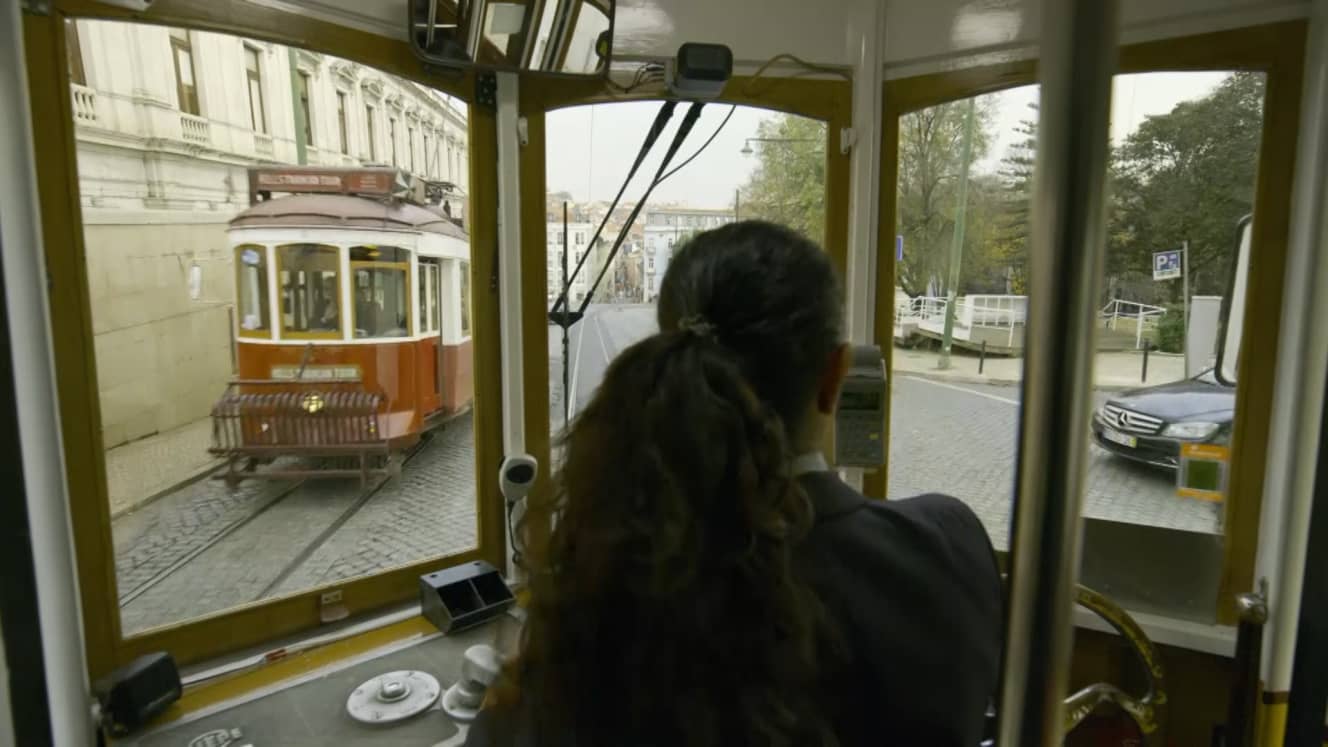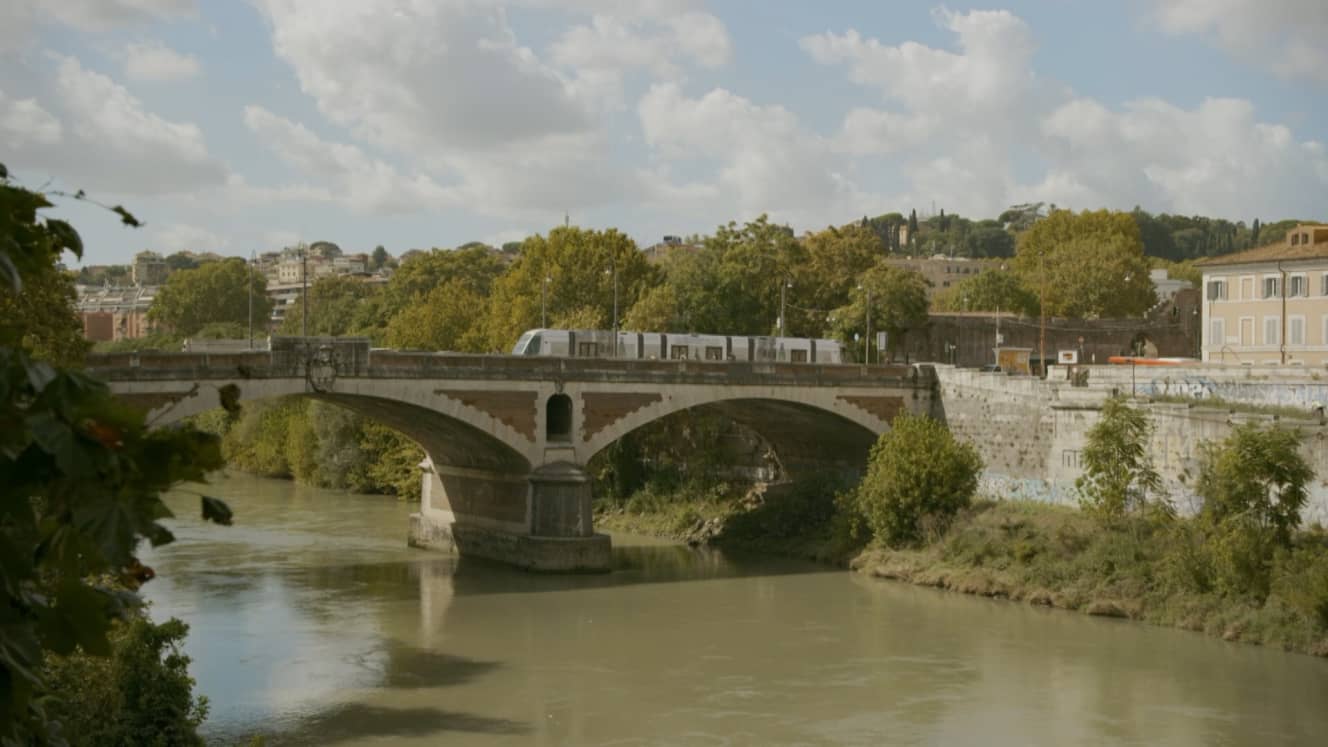No MC, no gourmet food, nothing! Just enjoy the view from the train window and the sound of the train…
Seriousness of “Europe Tram Trip
With the prolonged Covid-19 disaster, there must be many people who have a pent up desire to travel and go far away.
NHK’s “8K Europe: A Tram Journey” provides such people with a strange sense of travel reality.
There are no MCs, no guests, and almost no narration, just the scenery from the perspective of the streetcar riders in various European cities and occasional quiet music. There are no MCs, no guests, and almost no narration. There is no miscellaneous information about gourmet food, stores, etc. It is just a program to enjoy the view from the window and the sound of the train. Why such a program on the Covid-19 disaster?
The program’s chief producer, Kazuto Kimura (currently with NHK Content Development Center) and senior producer, Yoko Imai (NHK Enterprises), told us how the program came to be.


“The project began when we received an order to produce an 8K program in Europe that could be enjoyed over and over again while keeping production costs low.
We talked with Mr. Imai of NHK Enterprises and other producers in Tokyo at the time about what kind of travelogue program we could shoot in 8K that would buy us time and allow us to enjoy the essence of Europe, and we decided to put 8K equipment on a streetcar and shoot all the beautiful scenery, scenic spots, and beautiful things in the city. We decided to put 8K equipment on the tram and take pictures of beautiful scenery, scenic spots, and beautiful things in the city.
With 8K, the resolution of the images on the screen is high, and there is a huge amount of information. In addition, we shot the entire film on location with 5.1 surround sound, so when you watch it in 8K, you’ll feel as if you’re actually riding a streetcar and taking a leisurely trip through the city.
Until the end of August, Mr. Kimura had been on loan for five years to NHK Cosmomedia Europe, an overseas subsidiary of NHK Enterprises with offices in London and Paris.
There, he produced 4K and 8K programs such as a documentary on the birth of two Japanese principals in the Royal Ballet, 8K “Festivals of the World,” “Tomohiro Sekiguchi’s European Railroad Journey,” and “100 Years of Latvia: The Pride Connected by Song and Dance.
By the way, the original 8K version started in December 2018, but most viewers are watching the 60-minute compilation version that has been aired on NHK General, BS Premium, and BS1 in the late evening since February 2020.
What’s more interesting is that the original 8K version has “too much information,” so the viewing location changes depending on the person and the time.
“For example, when driving through the streets of Prague, people who are interested in architecture will see the architecture, people who are interested in fashion will see the show windows and the fashions of people walking on the streets, and people who are interested in cars will see the cars.
But that’s what travel is all about, isn’t it? Each person has a different purpose and wants to see different things.
That’s why my policy was that I never want the producers to put information on the message board telling people to watch this.
I’m sure NHK wanted to give us more information, but I think most of the viewers nowadays want to investigate and check what they feel on their own, rather than being told from the top. That’s why we decided to steer the program away from miscellaneous information in order to make it more viewer-oriented.
Yoko Imai describes her impression when she saw Kimura’s proposal.
“In Scandinavia, there is a genre called ‘slow TV’.
For example, in Sweden, there is a program in which multiple cameras spend hours just following the seasonal migration of moose in the wilderness; in Norway, there is a program that spends about nine hours filming the windows and interior of a train from the beginning to the end of the journey; and there is a program in which grandmothers start and finish knitting yarn. There was also a program that filmed grandmothers knitting for nine hours straight, from start to finish.
Five or six years ago, such programs started to become a hot topic in the content market and established a genre called “slow TV”, which I thought was similar to that.
Nowadays, people don’t stare at the TV, but rather watch it while doing something else. I thought it would be a good experiment to see if people would be able to watch it in the middle of the night while talking, relaxing, or thinking, especially on the BS and general TV channels they are watching now.


By the way, the first place they filmed for the trial was Lisbon. ……
“Of course the windows were interesting, but the conversations that took place inside the car were also interesting.
Of course, the windows are interesting, but the conversations that take place inside the car are really interesting. Even though the big camera is set up behind the driver’s seat, an old man goes next to the driver and talks about trivial gossip in a typical Latin way.
With 8K, you can hear not only the images, but also the smells of the place and the conversations of the people in the train.
It’s also interesting to note that streetcars, unlike regular trains, have signal waits. Especially in the Lisbon, Portugal section, there are times when the streetcar can’t move forward because of the traffic jam that fills the narrow streets, and during the preview, everyone unconsciously stretches to see what’s happening outside (laughs).
(laughs) This happens because of the realistic feeling of actually riding the streetcar.


Incidentally, the filming period for two broadcasts in one city is about three days and two nights. This is a very demanding schedule, as the filming is done in a limited time frame and with pinpoint accuracy, so as not to disturb the general public as much as possible.
“We started out with one 8K camera shooting the front, then the right side, then the left side, and so on, but halfway through, we had one 8K camera and two 6K cameras. In order to keep the camera from shaking, we put a rubber sheet on the floor, put a heavy tripod on top of it, and secured it with a sand bag so that it would never fall.
The shooting staff consisted of a cameraman, an assistant cameraman, a person dedicated to 8K’s unique focus, a 5.1 surround sound man, a person to process the shooting data, a director, and a driver.
We can only shoot for one hour at a time, and we have to process the data immediately, so we have to ask the driver to go ahead and change the equipment at the next point, and sometimes we have to ride back with heavy equipment, so it’s an acrobatic shoot,” said Kimura.


Furthermore, the difficulty of location shooting differs from city to city.
“Summer is still good, but winter is hell. In Krakow, Poland, in particular, the sun comes up at around 8:00 a.m. and goes down around 2:00 p.m., so you have to eat a lot of breakfast. So I had to eat a lot of breakfast and take a lot of pictures at once, and then after 2pm, I had to eat lunch and dinner as well and just process the data.
Also, there were a lot of rules and regulations, and it was very difficult to get permission in Germany, while it was easiest in Portugal, where they said, ‘You can take whatever you want.
He also said that some train fans said they wanted more information about the cars and cabins.
“The interesting thing is the Serbian rolling stock. The interesting thing is the Serbian rolling stock, which was acquired from neighboring countries such as the Czech Republic and Switzerland, and they run it in its original form without any modification, so there are many different colors of rolling stock running around the city. They say they are grateful for the fact that they are able to run the cars in their original form.


Lastly, we asked both of them what they would recommend.
“In terms of sound, we use music associated with the city, such as music by Liszt for Budapest and Chopin for Poland.
However, the main focus is on the sound of the streetcars rumbling, so we try to keep the live sound inside the trams without any music.
In the 8K version, you can also hear the sounds of the city, such as the sounds of the 13th century clock tower in Prague, the trumpets that sound every hour at St. Mary’s Church in Krakow, and the sound of horse-drawn carriages passing on the cobblestones.
Mr. Kimura said, “The most fascinating streetcar videos are of Prague in the Czech Republic, Hungary, Rome, Vienna, and Amsterdam. Places not often visited by Japanese people, such as Latvia, Estonia, and Leipzig in Germany, were also good.
On the whole, countries that were part of the Soviet bloc have more streetcars in their cities, but environmental issues have caused streetcars to be reevaluated, and now they are being revived in the suburbs of Paris, so it is interesting to see modern history and culture.
Since it is broadcasted irregularly late at night on NHK General, BS Premium, and BS1, “Tram Travel in Europe” has become something that you are lucky if you happen to come across. I would love to see the 8K version someday so that I can experience its true power.
For the broadcast schedule of “8K Europe Tram Travel” (NHK), click here.
Reporting and writing by: Wakako Tago
Born in 1973. After working for a publishing company and an advertising production company, became a freelance writer. In addition to interviewing actors and actresses for weekly and monthly magazines, she writes drama columns for various media. JUMP 9 no Tobira ga Openitoki" (both published by Earl's Publishing).